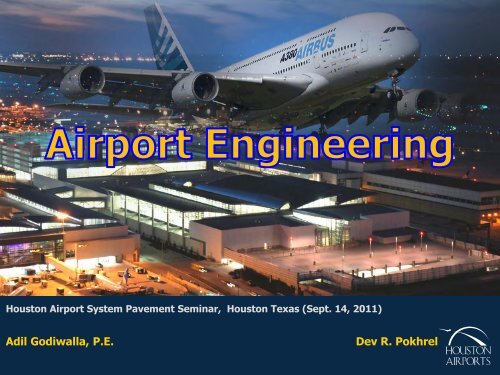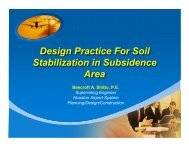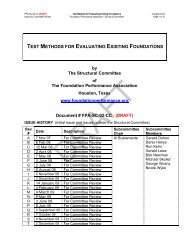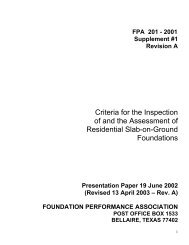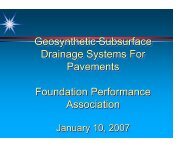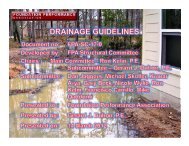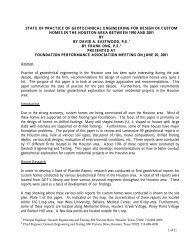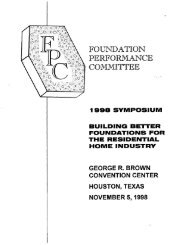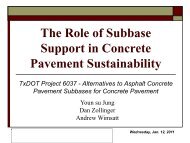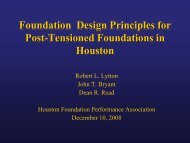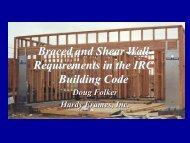Airport Engineering - Foundation Performance Association
Airport Engineering - Foundation Performance Association
Airport Engineering - Foundation Performance Association
You also want an ePaper? Increase the reach of your titles
YUMPU automatically turns print PDFs into web optimized ePapers that Google loves.
Houston <strong>Airport</strong> System Pavement Seminar, Houston Texas (Sept. 14, 2011)<br />
Adil Godiwalla, P.E. Dev R. Pokhrel
AIRPORT ENGINEERING<br />
Adil Godiwalla, P.E. 1<br />
(MS Civil <strong>Engineering</strong>)<br />
Assistant Director, Design Division<br />
City of Houston Government, Department of Aviation<br />
Dev Raj Pokhrel2 (MS Environmental Management/ MS Civil <strong>Engineering</strong>)<br />
Graduate Engineer, Design Division, Houston <strong>Airport</strong> Systems<br />
ABSTRACT<br />
Recent developments in computer design software for airfield pavement design, have simplified the design process to a great<br />
extent. The Federal Aviation Administration’s Rigid and Flexible Iterative Elastic Layered Design software (FAARFIELD) is<br />
one of their newly released design programs. FAARFIELD is based on AC 150/5320-6E, which includes Finite Elemental<br />
Modeling approaches. For flexible pavement design, FAARFIELD uses the similar structural response and failure models as<br />
LEDFAA 1.3. For rigid and overlay pavement design, FAARFIELD combines a three-dimensional finite element analysis<br />
with a performance/failure model based on full scale test result from National <strong>Airport</strong> Pavement Test Facility (NAPTF) and<br />
re-analysis of USACE full scale test results. With the application of appropriate calibration factors, FAARFIELD is<br />
considered one of the most effective tools in simulating and material modeling. FAARFIELD is also capable of handling<br />
New Large Aircrafts (NLA) with complex landing gear configuration including B-777, Airbus A380 and An-225. Other<br />
recent developments in pavement management software includes COMFAA 3.0 (as per AC150/5335-5B) and FAAPAVEAIR<br />
(Beta Version, expected to release soon). The objective of this paper is to introduce <strong>Airport</strong> <strong>Engineering</strong>, some of the<br />
innovative pavement technologies in computer design software-Finite Elemental Modeling, Pavement Management<br />
Technologies and various Decision making criteria “Decision Matrix” that have been using at Houston <strong>Airport</strong> Systems for<br />
several years. Pavement strength evaluation techniques and reporting criteria based on ACN-PCN evaluation using recent<br />
updated version of COMFAA 3.0, and application of NDT for sub-grade modulus evaluation and their implication on ACN-<br />
PCN determination are also presented and discussed. Finally, the outcomes of preliminary investigation on “Evaluation of<br />
Corrosion Potential of Native Sub-grade Soils though Soils Resistivity Analysis at Houston <strong>Airport</strong>s Systems” are also<br />
presented.<br />
Key Words: Soil, Pavement Design, FAARFIELD, COMFAA, ACN/PCN, NDT, Corrosion, Resistivity
Overview<br />
<strong>Airport</strong> <strong>Engineering</strong><br />
1. Introduction to Houston <strong>Airport</strong> Systems<br />
2. Introduction to Pavement Design and Design Software<br />
3. Pavement Management System<br />
4. Soils Resistivity and Corrosion Potential of Native Subgrade<br />
Soils at Houston <strong>Airport</strong> Systems
Section-1: Introduction<br />
•Houston <strong>Airport</strong> System<br />
•General <strong>Airport</strong> Features<br />
•Instrumentation Landing Systems
LOCATION MAP: HOUSTON AIRPORT SYSTEMS<br />
Houston, Texas<br />
George Bush<br />
Intercontinental <strong>Airport</strong><br />
William P. Hobby <strong>Airport</strong><br />
Ellington <strong>Airport</strong>
Aerial Map – George Bush Intercontinental<br />
<strong>Airport</strong>
5 Major Runways<br />
8L/26R=9,000’ 8R/26L =9,400’ 9/27=10,000’<br />
15L/33R=12,000’ 15R/33L=10,000
William P. Hobby <strong>Airport</strong>
Ellington <strong>Airport</strong>
Ellington <strong>Airport</strong><br />
This <strong>Airport</strong> is Currently Operated by Military, NASA ,<br />
and General Aviation
General <strong>Airport</strong> Features<br />
• Terminal Buildings/Control Tower<br />
• Runways/Taxiways<br />
• Instrumentation Landing System<br />
• Jet Bridge/ Gates<br />
• Fuel Tank/Pipelines<br />
• Strom Water Management/Sewer Systems<br />
• Detention Pond/ Lift Stations<br />
• Air quality/Noise/Hazardous Material<br />
• Wetland/Biotic Communities
Instrumentation Landing System<br />
Glide Slope & Antenna<br />
Corrects the Descent Path in V.<br />
Direction<br />
• Located Between 750’-1250’ From the<br />
Approach end of Runway<br />
• Transmits a Glide Path Beam at 1.4<br />
Degree Wide<br />
• Path Projection of 3 Degree
Instrumentation Landing System<br />
Localizer & Marker<br />
Transmits Signals To The Pilot<br />
Provide Lateral Guidance<br />
Aligns Horizontal Position with Runways
Navigational Aids & Other FAA-Operated Facilities<br />
• <strong>Airport</strong> Surveillance Radar<br />
• Navigational Aids And Lighting Systems<br />
• Doppler Radar- Enhance Weather Prediction<br />
• Low level Wind Shear System<br />
• Aircraft Rescue And Firefighting Facility<br />
Ground Based Augmentation System to Global Positioning System (GPS) provides<br />
a very precise navigation service (low visibility conditions)
ILS
Section-2<br />
Pavement Design and Design Software
Design- Components<br />
Design Components- Pavement design
Fundamental of Pavement Design<br />
Pavement Types<br />
Rigid PCC<br />
•Jointed Plain Concrete Pavement(JPCP/JCP)<br />
•Jointed Reinforced Concrete Pavement –(JRCP)<br />
•Continuously Reinforced Concrete Pavement-CRCP<br />
•Pre-stressed Concrete Pavement-PCP<br />
Flexible ACP/HMA<br />
Full Depth<br />
Layered<br />
Granular<br />
Bound layers<br />
Surface Treatment<br />
Composite
Fundamental of Pavement Design<br />
Pavement Components<br />
Rigid Pavement<br />
Portland Cement Concrete Slab<br />
Base<br />
Sub-grade<br />
Flexible Pavement (Layered System)<br />
Asphaltic Wearing Surface<br />
Base<br />
Sub-base<br />
Sub-grade
Fundamental of Pavement Design<br />
Factors Affecting Pavement Design<br />
Types of Aircraft<br />
Loads<br />
Anticipated frequency<br />
Gear configuration<br />
Type of facility considered<br />
Runway<br />
Taxiway<br />
Apron<br />
Hangar Floor<br />
Supporting value of the sub-grade<br />
Characteristics of available construction Material
Fundamental of Pavement Design<br />
Wheel Loading<br />
Pavement Thickness<br />
Pavement Stiffness<br />
Environmental Loading – Temperature and Moisture<br />
Joint Spacing<br />
Reinforcement<br />
HMA Stiffness
Fundamental of Pavement Design<br />
Fundamental Design Concepts<br />
Application<br />
Load and Environment<br />
Principle of Superposition<br />
Stress Dependent On:<br />
Gear Spacing<br />
Magnitude and tire pressure<br />
Number of wheels<br />
Fatigue<br />
Layered Concept
Flexible Pavement Design<br />
Area of Tire Contact<br />
Must also guard<br />
against potential<br />
failure in base<br />
layers<br />
Approximate Line of<br />
Wheel-Load Distribution<br />
Wheel Load Horizontal Strain and<br />
Stress at the bottom of the<br />
asphalt<br />
Subgrade Support<br />
Wearing Surface<br />
Base Course<br />
Subbase<br />
Subgrade<br />
Vertical Subgrade Strain
Flexible Pavement Layer Parameters- LED vs.<br />
CBR<br />
LAYERED ELASTIC METHOD<br />
SURFACE E S, S, h<br />
BASE E B, B, h B<br />
SUBBASE E SB, SB h SB<br />
SUBGRADE E SG, SG h SG<br />
E = Elastic Modulus<br />
h = thickness<br />
μ = Poisson’s Ratio<br />
Wheel Load<br />
Subgrade Support<br />
CBR Method<br />
Not Defined<br />
CBR<br />
CBR<br />
CBR<br />
CBR = California<br />
Bearing Ratio
Flexible Pavement Design Based on Layered<br />
Elastic Design Procedure<br />
US Corp of Engineers CBR Method- no longer used.<br />
Rigid Pavement Design Based on 3-Dimensional<br />
Finite Element Model<br />
Westergaard design procedure no longer used.
Traffic Models<br />
New procedures require that ALL anticipated<br />
traffic be included in the traffic model.<br />
Concept of “Design Aircraft” is no longer used<br />
Cumulative Damage Factor (CDF) replaces<br />
need for design aircraft procedure.
HISTORICAL DESIGN PROSPECTIVE<br />
CBR METHOD: Flexible Pavement<br />
Westergaard’s Approach-(Rigid<br />
Pavement)
EQUIVALENT TRAFFIC METHOD (FAA,1975)<br />
Determination of annual aircraft departure by each aircraft and convert them into<br />
equivalent annual departure in terms of landing gear configuration
RUNWAY LENGTH DETERMINATION<br />
FACTORS: ELEVATION, TEMPERATURE, PRESSURE AND MTOW
Selection of Pavement Material and<br />
Specification<br />
Surface BASE SUBBASE SUBGRADE<br />
P-401 P-209 P-154 P-152<br />
P-403 P-208 P-210 P-155*<br />
P-501 P-211 P-212 P-157*<br />
P-304* P-213 P-158*<br />
P-306* P-301*<br />
P-401*<br />
P-403*<br />
Rubblized PCC<br />
* Chemically Stabilized Materials
• 75% load Transfer to adjacent slab
DEVELOPMENT OF PAVEMENT DESIGN SOFTWARE<br />
LEDFAA<br />
AC 150/5320-6D<br />
AC 150/5320-6E<br />
1995<br />
COMFAA<br />
FEAFAA<br />
FAARFIELD<br />
2009
Gear Configuration & Naming Convention- Complex<br />
Aircraft<br />
AN-125 AN 225<br />
3D<br />
B 777
INTRODUCTION-TO FINITE ELEMENTAL<br />
MODELING- FAARFIELD<br />
Based on - Layered Elastic and<br />
3D-FE modeling<br />
AC 150/5320-6E (Current)<br />
Computer Programs:<br />
• LEAF (layered elastic analysis)<br />
Visual Basic 2005<br />
• NIKE3D (3D finite element analysis)-<br />
FORTRAN<br />
• INGRID (3D mesh generation)
INTRODUCTION-TO<br />
FINITE ELEMENTAL MODELING<br />
Screen Shot: Structure<br />
Screen Shot: Traffic
Curling Stress<br />
FEM Model Approach
FEM Model Approach
Cumulative Damage Factor (CDF) for<br />
Some Aircraft<br />
Annual CDF CDF Max<br />
Aircraft Name Gross Weight Departures Contribution For Aircraft<br />
Sngl Whl-30 30,000 1,200 0.00 0.00<br />
Dual Whl-30 30,000 1,200 0.00 0.00<br />
Dual Whl-45 45,000 1,200 0.00 0.00<br />
RegionalJet-200 47,450 1,200 0.00 0.00<br />
RegionalJet-700 72,500 1,200 0.00 0.00<br />
Dual Whl-100 100,000 1,200 0.00 0.00<br />
DC-9-51 122,000 1,200 0.01 0.01<br />
MD-83 161,000 1,200 0.39 0.39<br />
B-737-400 150,500 1,200 0.09 0.09<br />
B-727 172,000 1,200 0.23 0.24<br />
B-757 250,000 1,200 0.02 0.03<br />
A300-B2 304,000 1,200 0.01 0.16<br />
B-767-200 335,000 1,200 0.02 0.15<br />
A330 469,000 100 0.01 0.23<br />
B-747-400 873,000 100 0.23 0.28<br />
B-777-200 537,000 500 0.00 0.13
EFFECT OF GEAR POSITION & CRITICAL STRESS<br />
LOCATION<br />
Rigid pavement thickness is designed based on critical tensile<br />
bending stress at the bottom of the slab. Top-Down cracking may<br />
occur under certain combined Loading and pavement geometry<br />
configuration<br />
(Full scale test - NAPTF and Airbus PEP )<br />
Guo (2006) reported that tensile stress developed on slab bottom<br />
were related primarily to the wheel load, while the tensile<br />
stresses on the slab top were related primarily to the gear load<br />
at both longitudinal and transverse joint location.
EFFECT OF GEAR POSITION & CRITICAL STRESS<br />
LOCATION<br />
2D Simulation on 9 slab (University of Urbana-Champaign)<br />
• Four main landing gear (B-777, A-380, MD-11, & B747)<br />
• Five individual aircraft gear geometry-Dual -B737<br />
Dual Tandems- B747, B757, B767<br />
Triple Dual Tandems-B-777<br />
1. Individual Gear Analysis: (with assumption of no initial curling<br />
stresses)<br />
2. Main landing Gear Analysis (two load transfer efficiencies (0 and<br />
85%) were assumed across the joint)
EFFECT OF GEAR POSITION & CRITICAL STRESS<br />
LOCATION<br />
1.Individual Gear Analysis: (with assumption of no initial curling stresses)<br />
• Due to small wheel spacing, B-737 produced greatest tensile stress at the bottom of<br />
the slab in y direction.<br />
• The largest Tensile stress at the top of the slab is came from TDT gear (B-777)<br />
in x- direction.<br />
• Max. tensile stress at top was similar in both direction for each gear type.<br />
• Gear load affected the max tensile stress at the top of the slab while wheel affected<br />
the max tensile stresses at the bottom of the slab.<br />
• Top-down cracking depends on top to bottom tensile stress ratio.<br />
• B-777 produced the highest tensile stress ratio.
EFFECT OF GEAR POSITION & CRITICAL STRESS<br />
LOCATION<br />
2. Main landing Gear Analysis (two load transfer efficiencies (0 and<br />
85%) were assumed across the joint)<br />
• As the load transfer efficiency at the joints decreased for all aircraft, the<br />
max. tensile stresses at the top and bottom increased.<br />
• The main landing gear of A-380 resulted in the highest top tensile stress.<br />
• Max tensile stress on the top of the slab was in x-direction, which indicates<br />
that longitudinal cracking would be the most likely failure mode.<br />
• MD-11 and A-380 have significantly higher tensile stresses at the bottom of<br />
the slab in y-direction compared to the tensile stress in x-direction, which<br />
would first lead to bottom –up transverse cracking.<br />
• Due to large spacing between the main landing gear in B-777, produced<br />
lower top tensile stress in the main landing gear.
Runway Centerline .<br />
Large Aircraft Traffic Mix Gear Locations<br />
0 25 50 75 100 125 150 175 200 225 250 275 300 325 350 375 400<br />
Distance From Centerline (in)<br />
B-777-200<br />
B-747-400<br />
A-330<br />
B-767-200<br />
A-300-B2<br />
B-757<br />
B-727<br />
B-737-400<br />
MD-83<br />
MD-90-30<br />
DC-9-50<br />
DW 100,000<br />
Regional Jet 700<br />
Regional Jet 200<br />
DW 45,000<br />
DW 30,000<br />
SW 30,000
EFFECT OF GEAR POSITION & CRITICAL STRESS<br />
LOCATION<br />
• Tensile stress at the bottom of the slab are more critical.<br />
• The main landing gear of A-380 resulted in the largest top tensile<br />
stress.<br />
• The ratio of top to bottom of the slab tensile stress were significantly<br />
higher for full gear analysis relative to the individual gear analysis.<br />
• The critical top tensile stress occurred at the transverse joint would<br />
promote propagation of longitudinal cracks.
TOUCHDOWN IMPACT AND STRESSES<br />
• During the touch down operation<br />
less than 50% of the weight of<br />
aircraft impacts on pavement.<br />
• Aircrafts are lighter due to<br />
burning of fuel in the flight.<br />
• A partial weight is taken by the flaps<br />
(opening of flaps during touchdown)<br />
• Flaps changes horizontal energy to vertical energy which allow<br />
to decrease the sink rate prior to touchdown.<br />
• The more flaps available and used, the slower the speed, the<br />
slower the touchdown and shorter the rollout.
Flap Effects<br />
• Increase lift<br />
Increase drag<br />
More abrupt stall<br />
Lower stall speed<br />
• Decrease climb rates<br />
Change pitch attitude<br />
Increase approach angle<br />
Decrease distance to lift-off<br />
Shorten Takeoff and Landing distance
CDF Comparison for Group IV, V, and VI Aircraft
FAARFIELD DESIGN OUTPUT TW- WB<br />
No. Type<br />
Thickness<br />
in<br />
Modulus<br />
psi<br />
Poisson's<br />
Ratio<br />
Strength<br />
R,psi<br />
1 PCC Surface 19.00 4,000,000 0.15 700<br />
2 Undefined 16.00 500,000 0.35 0<br />
3 Undefined 8.00 40,000 0.35 0<br />
4 Subgrade 0.00 4,000 0.40 0<br />
Total thickness to the top of the sub-grade = 43.26 in<br />
No. Name<br />
Gross Wt.<br />
lbs<br />
Annual<br />
Departures<br />
% Annual<br />
Growth<br />
1 DC8-43 318,000 227 2.00<br />
2 DC9-32 109,000 69 2.00<br />
3 DC9-51 122,000 100,000 2.00<br />
4 DC9-51 122,000 36,511 2.00<br />
5 DC10-30/40 583,000 2,522 2.00<br />
6 DC10-30/40 Belly 583,000 2,522 2.00<br />
7 Adv. B727-200C Basic 185,200 14,781 2.00<br />
8 B737-300 140,000 82,956 2.00<br />
9 B737-800 174,700 77,036 2.00<br />
10 B747-400B Combi 877,000 103 2.00<br />
11<br />
B747-200B Combi<br />
Mixed<br />
836,000 929 2.00<br />
12 B757-200 256,000 478 2.00<br />
13 B777-200LR 768,000 10,258 2.00<br />
14 A320-100 150,796 1,964 2.00<br />
15 A340-200 std 568,563 3,647 2.00<br />
16 A340-200 std Belly 568,563 3,647 2.00<br />
17 Fokker-F-28-1000 66,500 272 2.00<br />
18 Dual Tan-400 400,000 171 2.00<br />
19 Dual Tan-400 400,000 46 2.00<br />
20 A380-800 1,239,000 46 2.00<br />
21<br />
B747-8 Freighter<br />
(Preliminary)<br />
978,000 100 2.00<br />
22 B787-8 (Preliminary) 486,000 100 2.00<br />
23 B777-300 ER 777,000 2,000 2.00<br />
24 B747-400ER Passenger 913,000 100 2.00<br />
25 B787-8 (Preliminary) 545,000 100 2.00
FAARFIELD OUTPUT TW-WB<br />
No. Name<br />
CDF<br />
Contribution<br />
CDF Max<br />
for Airplane<br />
P/C<br />
Ratio<br />
1 DC8-43 0.00 0.00 3.34<br />
2 DC9-32 0.00 0.00 3.65<br />
3 DC9-51 0.00 0.00 3.64<br />
4 DC9-51 0.00 0.00 3.64<br />
5 DC10-30/40 0.00 0.00 3.55<br />
6 DC10-30/40 Belly 0.00 0.00 2.89<br />
7<br />
Adv. B727-200C<br />
Basic<br />
0.00 0.00 2.92<br />
8 B737-300 0.00 0.00 3.79<br />
9 B737-800 0.00 0.01 3.52<br />
10 B747-400B Combi 0.00 0.00 3.46<br />
11<br />
B747-200B Combi<br />
Mixed<br />
0.00 0.00 3.46<br />
12 B757-200 0.00 0.00 3.90<br />
13 B777-200LR 0.80 0.80 3.86<br />
14 A320-100 0.00 0.00 3.84<br />
15 A340-200 std 0.00 0.00 1.89<br />
16 A340-200 std Belly 0.00 0.00 2.99<br />
17 Fokker-F-28-1000 0.00 0.00 3.60<br />
18 Dual Tan-400 0.00 0.01 3.19<br />
19 Dual Tan-400 0.00 0.00 3.19<br />
20 A380-800 0.00 0.00 3.61<br />
21<br />
B747-8 Freighter<br />
(Preliminary)<br />
0.00 0.00 3.56<br />
22 B787-8 (Preliminary) 0.00 0.00 3.78<br />
23 B777-300 ER 0.19 0.19 3.86<br />
24<br />
B747-400ER<br />
Passenger<br />
0.00 0.00 3.62<br />
25 B787-8 (Preliminary) 0.00 0.01 3.78
FAARFIELD: Horizontal Stress at the<br />
Bottom of PCC Slab<br />
Stress Computation for TW-WB, output from FAARFIELD
FAARFIELD: Stress/Strain Analysis at the<br />
Bottom of the Flexible Pavement<br />
Stress Computation for TW-WB Shoulder, output from FAARFIELD
Section-3<br />
Pavement Evaluation & Management<br />
System<br />
•Pavement Strength Evaluation and Rating process<br />
PCI Rating<br />
NDT<br />
ACN-PCN Evaluation<br />
•Life Cycle Modeling<br />
•Decision Matrix<br />
•Pavement Management Software<br />
•Evaluation of Concrete and Metal Structure through Soils Resistivity Analysis
• To Evaluate the current Pavement condition<br />
• Detail Plan for repair ( what/When/How..)<br />
• Cost Benefit Analysis<br />
• Justification<br />
• What happens if not repair at this point ?<br />
All these are answered
Pavement Evaluation & Rating Process<br />
Pavement Condition Index (PCI)<br />
Structural Condition Index (SCI)<br />
NDT And Back Calculation for<br />
Strength Evaluation, Validate<br />
w/Field Testing<br />
Traffic Analysis- AIRPAVE<br />
ACN-PCN Evaluation<br />
Pavement Thickness<br />
COMFAA<br />
BACKFAA<br />
FAARFIELD<br />
Minimum Service Level<br />
Runways 75<br />
Taxiways 70<br />
Aprons 65
AC 150/5380-6<br />
ASTM D 5340-10<br />
Distress Severity, Qty. &<br />
Type<br />
Pavement Evaluation: Distresses<br />
Flexible pavement Rigid pavement<br />
Alligator Blow Up<br />
Bleeding Corner Break<br />
Block Cracking LTD Cracking<br />
Corrugation D- Cracking<br />
Depression Joint Seal Damage<br />
Jet Blast Erosion Large Patch<br />
Long,.& Trans. Cracking Small Patch<br />
Oil Spill Pumping<br />
Joint Refl. Cracking Pop Outs<br />
Polished Agg. Faulting<br />
Raveling/Weathering Shattered Slab<br />
Rutting Shrinkage<br />
Shoving From PCC Joint Spalling<br />
Slippage Corner Spalling<br />
Swelling
Strength Evaluation: NDT Modulus (Back-calculation)<br />
Modulus (psi)<br />
3000000<br />
2500000<br />
2000000<br />
1500000<br />
1000000<br />
500000<br />
0<br />
2050 2100 2150 2200 2250<br />
Top layer<br />
Pavement Section<br />
Modulus(psi)<br />
60000<br />
50000<br />
40000<br />
30000<br />
20000<br />
10000<br />
0<br />
Modulus(psi)<br />
2050 2100 2150 2200 2250<br />
Pavement Section<br />
Sub-grade<br />
600000<br />
500000<br />
400000<br />
300000<br />
200000<br />
100000<br />
0<br />
2050 2100 2150 2200 2250<br />
Pavement Section<br />
Base layer
Determination of ACN-PCN Using COMFAA 3.0<br />
COMFAA 3.0 Screen Shot and Equivalent Section Determination
0<br />
5<br />
Depth from Surface, in.<br />
10<br />
15<br />
20<br />
25<br />
0<br />
5<br />
Depth from Surface, in.<br />
10<br />
15<br />
20<br />
25<br />
30<br />
35<br />
Existing Pavement<br />
P-501<br />
flex<br />
strengt<br />
h = 750<br />
psi.<br />
P-301<br />
Subgra<br />
de k=<br />
69<br />
Existing Pavement<br />
P-401<br />
P-301<br />
ACN-PCN Evaluation Using COMFAA 3.0<br />
Equivalent<br />
Pavement<br />
P-501<br />
flex<br />
strengt<br />
h = 750<br />
psi.<br />
Uncrus<br />
hed k =<br />
145<br />
Subgra<br />
de k=<br />
69<br />
Equivalent<br />
Pavement<br />
P-401<br />
P-209<br />
P-154<br />
Example Output from COMFAA 3.0 TW SA/SB<br />
PCN Reporting Format:<br />
PCN Number/Pavement Type/Tire Pressure/Method of Calculation (Technical/Using Airplane)
FACTORS AFFECTING ACN-PCN EVALUATION<br />
•Sub-grade Modulus<br />
•Pavement Thickness<br />
•Traffic loading/type and Gear<br />
•<strong>Engineering</strong> Judgment (Personal decisions)<br />
ACN/PCN<br />
260<br />
240<br />
220<br />
200<br />
180<br />
160<br />
140<br />
120<br />
100<br />
80<br />
60<br />
40<br />
20<br />
0<br />
Evaluation,<br />
3 4 5 6 7 8<br />
CBR<br />
ACN@65.6"<br />
ACN @41.6"<br />
PCN@65.6"<br />
PCN@41.6"<br />
Example: TW SA/SB Section #2108 Evaluation with DMJM Traffic -Projection
Life Cycle Cost Analysis<br />
LCCA Model
PAVEAIR: Web Based Project Management Tool<br />
Pave Air Beta Version
Rehabilitation Alternatives and Decision Making Criteria<br />
Rehabilitation of Taxiways WA-WB and New West Vault
Rehabilitation Alternatives and Decision Making Criteria<br />
Rehabilitation of Runway 9-27<br />
Final <strong>Engineering</strong> Report
Section-4<br />
Soils Resistivity and Corrosion Potential of<br />
Native Sub-grade Soils
Deterioration of Concrete and Metal Structures<br />
Concrete and metal structures are deteriorated at<br />
faster rate with soils corrosion activity. Soils<br />
Corrosivity is measured by Soils Resistivity
Soils Resistivity Testing<br />
Method of Soils Resistivity Testing<br />
Field Testing<br />
Lab Testing<br />
G.L.<br />
b<br />
a b<br />
Pin C1 Pin P1 Pin P2 Pin C2<br />
Schematic Diagram For Field Testing Setup
Factors:<br />
SOILS RESISTIVITY<br />
• Soils PH<br />
• Mineral Content (Chloride And Sulfate Ions)<br />
• Soils Types<br />
• Moisture Content<br />
• Temperature and Environment
pH Concentration and Corrosion Rate<br />
pH<br />
8.5<br />
8<br />
7.5<br />
7<br />
6.5<br />
6<br />
5.5<br />
5<br />
4.5<br />
4<br />
Soils pH<br />
0 5 10 15 20<br />
Depth(ft)<br />
General Trend of Soils pH To Rate of Corrosion<br />
High Moisture Content (Shallow Water Table)<br />
High Temperature<br />
Acidic Environment<br />
Highly Plasticity Soils<br />
Will Clayton<br />
Tank Farm<br />
These conditions may accelerate corrosion activity<br />
B-2<br />
B-3
Total Sulfates (% by wt)<br />
Sulfate and Chloride Ion Concentration<br />
Sulfate Exposure Water Soluble Sulphates<br />
0.012<br />
0.01<br />
0.008<br />
0.006<br />
0.004<br />
0.002<br />
0<br />
(So4) ( in % by wt.)<br />
Neglibible 0.00≤SO4
Resistivity (Ohm-cm)<br />
Resistivity (Ohm-cm)<br />
12000<br />
11000<br />
10000<br />
9000<br />
8000<br />
7000<br />
6000<br />
5000<br />
4000<br />
3000<br />
2000<br />
1000<br />
0<br />
10000<br />
9000<br />
8000<br />
7000<br />
6000<br />
5000<br />
4000<br />
3000<br />
2000<br />
1000<br />
0<br />
Soils Resistivity Test Results<br />
FIELD Soils Resistivity Testing IAH<br />
0 10 20 30 40 50<br />
Depth (ft)<br />
LAB Soils Resistivity Testing-IAH<br />
0 10 20<br />
Depth (ft)<br />
30 40<br />
will clayton test -1<br />
tank farm test-2<br />
IAH B-3<br />
test 1<br />
Test 3<br />
Tank farm<br />
B-1<br />
Resistivity (Ohm-cm)<br />
1200<br />
1100<br />
1000<br />
900<br />
800<br />
700<br />
600<br />
500<br />
400<br />
FIELD Soils Restivity (Hobby)<br />
0 20 40 60<br />
Depth (ft)<br />
Soil Corrosion Rating<br />
test H-1<br />
Resistivity (in Ohm-cm) Corrosion State<br />
Test H-2<br />
Test H-3<br />
Higher than 20,000 Essentially non corrosive<br />
10,000-20,000 Mild corrosive<br />
5000-10000 Moderately corrosive<br />
3000-5000 Corrosive<br />
1000-3000 Highly corrosive<br />
Less than 1000 Extremely corrosive
Research on Soils Resistivity Testing is Going on<br />
S
References:<br />
•Brill, D.R. (2010). “Calibration of FAARFIELD Rigid Pavement Design Procedure”, Final Report , U.S. Department of<br />
Transportation and Federal Aviation Administration, DOT/FAA/AR-09/57, Office of Research and Technology Development,<br />
Washington DC.<br />
•Federal Aviation Administration, Advisory Circular AC 150/5320-6E (2009). “<strong>Airport</strong> pavement Design and Evaluation”,<br />
U.S. Department of Transportation and Federal Aviation Administration.<br />
•Federal Aviation Administration, Advisory Circular AC 150/5335-5B (2011). “Standard Method of Reporting <strong>Airport</strong><br />
Pavement Strength –PCN”, U.S. Department of Transportation and Federal Aviation Administration.<br />
•Godiwalla, A. (2011). “Advanced, Modern and Innovative Technologies Used at Houston <strong>Airport</strong> Systems, Stabilized Subgrade<br />
and Stabilized Bases Pavement Surfaces”, Airfield <strong>Engineering</strong> S & Asset Maintenance Summit, Singapore Expo &<br />
Convention Center, Singapore.<br />
•Guo, E.H. (2006). “Fundamental Modeling of Curling Responses in Concrete Pavements.” 6 th International Workshop on<br />
Fundamental Modeling of Design and <strong>Performance</strong> of Concrete Pavements, Belgium.<br />
•Pokhrel, D.R. (2011). “Pavement Design and Management Systems at Houston <strong>Airport</strong> Systems”, Presented to the 4 th Annual<br />
Conference of American Society of Nepalese Engineers, July (9-10), Houston TX.<br />
•Pokhrel, D.R. (2011). “Current Status and Issues with the Geotechnical <strong>Engineering</strong> At Houston <strong>Airport</strong> System”, PDC<br />
Project Status Briefings, Department of Aviation, Houston <strong>Airport</strong> Systems.<br />
•Roesler, J., Evangelistra , F. Jr., & Domingues, M. (2007). “Effect of Gear Position on Airfield Rigid Pavement Critical Stress<br />
Location.” FAA Worldwide <strong>Airport</strong> Technology Transfer Conference, Atlantic City, New Jersey, USA.
For More Information Please Visit us @<br />
www.fly2houston.com


